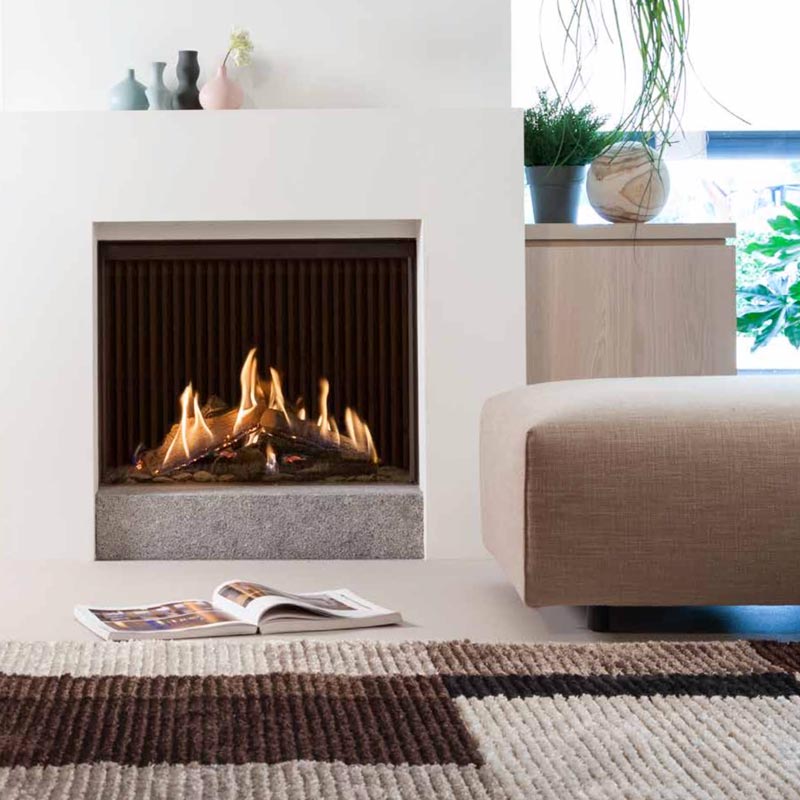FAQs

Frequently Asked Questions
We understand you may have many questions about fireplaces before you’re ready to make a selection. On this page we answer some of the questions we hear most often about fireplaces and installation.
Question 01 - Which heater is right for me?
Everybody is looking for something different from a heater. For some it’s the convenience of pressing a remote button to turn on their gas heater; for others it’s the emotion and satisfaction taken from building, lighting and enjoying a crackling open fire.
Question 02 - What kind of heaters are available?
Typically, heaters are broken down into either a freestanding unit, that is, one that sits on its own on a stand of some sort and has the flueing exposed; or an insert that is built within an enclosure, which could be a new enclosure or even an existing chimney.
But nowadays there can be combinations of both as people get creative with what's possible. This could mean a freestander that sits within a cavity or feature alcove and then flues up through an enclosure to hide the piping, or an insert that is housed within a boxed enclosure with the flue piping is exposed as a design statement. Or a two metre wide electric fire. Lots of possibilities.
But nowadays there can be combinations of both as people get creative with what's possible. This could mean a freestander that sits within a cavity or feature alcove and then flues up through an enclosure to hide the piping, or an insert that is housed within a boxed enclosure with the flue piping is exposed as a design statement. Or a two metre wide electric fire. Lots of possibilities.
Question 03 - Which heater works best?
This depends on what it is you require. We like to first ask whether a fire is for occasional use or is a primary heat source. Different heaters produce heat in different ways - European wood heaters tend to high efficiency, use of vermiculite firebox lining to concentrate heat for very hot burns from less wood, and quickly build into convecting heat by turning lower cold air and expelling it as hot air. Australian and US heaters tend to use heavier materials for the firebox and are built for long burn times and high radiant heating.
Gas heaters provide clean and quick heat and can be remarkably efficient with outstandingly realistic flames. All things being equal they aren't capable of heating as many square metres as the same sized sized closed wood heater.
Gas heaters provide clean and quick heat and can be remarkably efficient with outstandingly realistic flames. All things being equal they aren't capable of heating as many square metres as the same sized sized closed wood heater.
Question 04 - What's the difference between radiant and convected heat?
Radiant heat is 'line of sight' heating, ie, the heat you can feel directly from the fire. Stand in front of a heater and it is strong, move to the side and it is less so.
Convective heat is essentially a process where the heater expels hotter air from air galleys and channels. This in turn creates a vacuum that pulls in cool air which starts a convection cycle. It is an extraordinary way to take the most heat you can from a heater.
Convective heat is essentially a process where the heater expels hotter air from air galleys and channels. This in turn creates a vacuum that pulls in cool air which starts a convection cycle. It is an extraordinary way to take the most heat you can from a heater.
Question 05 - What heater will work in my space?
We can help you with this. Before you come and visit our showroom or call us, put a few notes together. Whether gas, wood or electric heater it is important for us to know the following so we can be the most helpful we can be:
For wood or gas heaters whether freestanding or enclosed, think about:
For wood or gas heaters whether freestanding or enclosed, think about:
- Measurements - the amount of square metres of floor area you are looking to heat. You don't want a heater that won't heat sufficiently, but neither to you want to 'over' fire where it's not necessary.
- The layout of the area where the heater will be placed, eg, open plan, can you close doors to the area, etc.
- The height of ceilings and whether they are vaulted or cathedral.
- The quality of the insulation, condition of seals around window frames, doors, cornices and skirting.
- The location of where you want to place the stove, eg, position in the room, on an internal or external wall, distance to combustible materials such as walls, windows and furniture.
- Pictures, Pictures, Pictures! The more pictures of the room or area you want to heat the better!
For wood or gas inserts into an existing chimney, think about the width, height and depth of the opening; the size of the area you want to heat; pictures of the fireplace, external walls and chimney; height of the chimney and whether the chimney finishes at the ceiling (many do) or continues right through to above the roofline.
Question 06 - What about installation?
We can arrange for an installer to come and assess your requirements and provide a formal quotation.
Question 07 - What does installation involve?
Depending on your situation, it can include building a new enclosure, installing flueing, removal of existing fires, gas plumbing and electrical connections for gas heaters.
Question 08 - How much is installation?
This can be accurately assessed after a discussion of your requirements. For a formal quote an installer can visit your site and assess. In the meantime, here is a guide:
- Freestanding wood fireplace - $650
- Freestanding gas fireplace - $800
- Standard wood fire insert into an existing chimney (may be additional for removal of bricks or existing fireplace) - $800 - $1,200
- Standard wood fire insert with hebel blocks supplied - $1,400
- Standard gas insert into standard enclosure with gas and electrical nearby - $800
- Standard gas insert into existing chimney, not including removal of existing bricks or fireplace - $800 - $1,000
- New enclosure with timber frame and by-rock with standard cornice, skirtings and ceiling height - $1,900
- Timber mantle and hearth install - $400
- Removal of existing fireplace if bricked in - $500+
- Removal of freestanding fireplace - approx. $350





